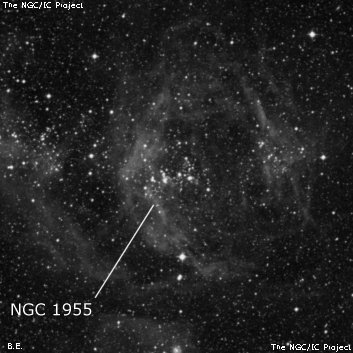
The cluster, which is part of stellar association LH 54, includes as many as 40 stars in a 4' region including a half-dozen mag 11.5-12.5 stars in a 3' gently curving arc elongated E-W. Near the W end of this arc is mag 11.6 HD 36402 = Brey 31, a Wolf-Rayet binary (WC-type).
The cluster is immersed in a large, irregular haze that was brightest on its eastern side in a 30" circular glow. This patch is just a locally brighter section of a large irregular loop bowed out to the east and extending N-S for 6'-7' to a mag 9.5 star 3.5' S of the cluster.
A fainter group of stars and haze lies 4' W (S-L 456 within association LH 51) and the DSS reveals both halves are the brightest portions of an 8' superbubble (LHa 120-N51D). NGC 1968 lies ~8' ENE and NGC 1974 11' NE.
James Dunlop discovered NGC 1955 = D 211 on 3 Aug 1826 and described "a small faint elliptical nebula, about 20" diameter. This is the preceding in a curved line of six or seven small nebulae, of unequal magnitudes." Dunlop made 4 observations and his position is just 1.6' too far SE. JH called NGC 1955 = h2863 "The second of a great line of rich clusters NGC 1968, 1974 and 1991] which are connected by abundant scattered stars. (The first not taken)." The first is probably S-L 456. JH credited Dunlop with the discovery.
600/800mm - 30" (11/5/10 - Coonabarabran, 264x): this cluster and emission nebula is near the western end of a beautiful curved chain of bright clusters involved with prominent nebulosity (referred to as the "Sextant Arc") that extends 17' WSW to ENE and includes NGC 1966 and NGC 1974 to the NE and S-L 456, a group of stars and nebulosity 4' W of NGC 1955.
Notes by Steve Gottlieb